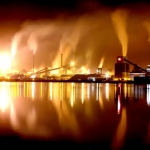INDIA: In Dabhol Lawyers, Leopards Dare Tread
Like a deserted castle, the silent Dabhol power plant on India's west coast looms large over the poor fishing villages below.
The $2.9 billion plant that bankrupt U.S. energy giant Enron built was a technological breakthrough and still represents the largest single foreign investment in India. But since shutting down almost four years ago, it has proven more of an embarrassment than a showcase.
Dabhol has been in legal limbo since the Maharashtra state utility, its exclusive customer, complained of rising rates and stopped paying its bills in 2001.
Dozens of court cases have been filed and legions of lawyers hired as lenders wrestle over the plant assets along with shareholders General Electric Co. and Bechtel.
As workers try to keep the plant rust-free in the salty air and ready for revival, the untamed countryside closes in. Locals often see leopards, wild pigs and monkeys roaming near the site.
The government set up a special committee to get Dabhol going again, not just because much of India is perpetually short of power, but also because many worry about the perception abroad.
"A foreign investor would certainly think twice now," said Rajeev Pawaskar, a geologist who helped oversee Dabhol's construction and now works with Bechtel as a consultant.
Given that Prime Minister Manmohan Singh is an economist and Finance Minister Palaniappan Chidambaram a former Dabhol Power Company lawyer, Pawaskar said the government was keenly aware of the importance of finding a resolution quickly.
In fact, a member of the committee said this month a solution was in sight, which would be a relief for Singh and Chidambaram, since the government faces legal claims of about $5 billion.
Bankers' Carve-Up
Once a deal is struck, state-run gas pipeline group GAIL says it and National Thermal Power Corp. will take over to get Dabhol running and prepped for sale.
A crucial question is how the assets will be divided. Indian banks, including ICICI Bank Ltd., state-run Industrial Development Bank of India Ltd. and State Bank of India, have lent $1.3 billion to the project.
Two dozen overseas creditors, including Bank of America Corp., Citigroup Inc. and ABN AMRO, lent about $600 million, though about half of that has been recovered.
"Domestic lenders have an edge," said one investment banker familiar with the negotiations. "If the foreign banks object, they'll just say 'fine, see you in court for the next 10 years'."
According to media reports, the Indian lenders have agreed in principle to buy the debt from the foreign lenders, with a view towards firing up the plant again in 2006.
Originally burning liquid fuel, Dabhol was upgrading to burn natural gas and expand its generating capacity when it closed.
To serve what was to be the world's largest gas-fired plant at the time, a liquefied natural gas terminal was built nearby to receive Middle East shipments from across the Arabian Sea.
When complete, the plant will generate an estimated 2,184 megawatts of power, enough for well over 2 million modern homes.
Leaping Legal Hurdles
The full implications of the prolonged Dabhol shutdown are hard to gauge. While India needs far more investment than it gets in order to develop, multinationals and money keep coming in.
"I wish the government had reacted faster and sorted it out," said Suresh Talwar, senior partner at Bombay law firm Crawford Bailey, which has worked for some of Dabhol's lenders.
"(But) the government also feels that international investors understand that one swallow doesn't make a summer."
India's investment climate has certainly improved since Enron started the project.
The Hindu nationalist Shiv Sena, founded to fight for the rights of the state's native Marathis and a member of the former central government, even campaigned to "Throw Enron into the Arabian Sea" at one stage.
Villagers in Veldoor, down the hill from the plant, were less concerned about its environmental impact than Enron's presence.
"We would have preferred it to have been an Indian company," said Dilip Pawar, a 36-year-old shopkeeper. Like many others, though, he looks forward to the day the plant reopens.
Sanjay Talsalkar, a former electrician at Dabhol now working in the area's dominant fishing industry, just wants his job back.
The plant is actually located across the Vashisthi River from Dabhol, a bustling village built around the ruins of a mosque.
Near the plant itself are the area's most recent relics. The shutters are down at abandoned shops outside the main gate. The sign for the empty Enron-built hospital is missing its 't'.
At dusk, uniformed maintenance workers walk down a little-used new road away from the plant, where the lights are on. Asked where the electricity comes from, one of them points to wires stretching overhead and off to the horizon.
"There's no power at the plant," he explains.
- 107 Energy
- 185 Corruption



